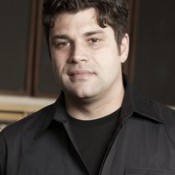The rise of the robot
It is one of the great truisms of our time that we live in an age of technological acceleration; the new paradigms keep rolling in, and the intervals between them keep shortening. This acceleration reflects not only the flood of new products, but also our growing willingness to embrace these strange new devices, and put them to use…It took ten years for color TV to go from the fringes to the mainstream; two generations later, it took HDTV just as long to achieve mass succeed.
In fact, if you look at the entirety of the twentieth century, the most important developments in mass, one-to-many communications clock in at the same social innovation rate with an eerie regularity. Call it the 10/10 rule: a decade to build the new platform, and a decade for it to find a mass audience.
Steven Johnson, Where Good Ideas Come From:
The Natural History of Innovation, 2010
As I gaze in the coming year’s crystal ball, I suspect that, at this time next year, we will be talking about 2013 being the rise of the robot.
A colleague of mine, Larry Birnbaum, likes to talk about how artificial intelligence has witnessed significant breakthrough in the past couple of years and that its tools are coming into maturity. In 2011, a computer won “Jeopardy” and Google gave us the driverless car, and this year, we began to see significant adoption of Apple’s virtual personal assistant service. Siri’s founder, Dag Kittlaus, made the rounds this year talking about how technology is good enough when its accuracy is around 90–95% — the tipping point from cool and experimental to utility. He has high hopes for the coming year in artificial intelligence development.
 If I get my wish, 2013 will produce the ultimate to-do/productivity app that not only tracks my tasks for me, but also completes some of them. It would be the smartest task-tracker robot ever, because it would know which tasks it could (and could not) complete, and it would just do the work for me.
If I get my wish, 2013 will produce the ultimate to-do/productivity app that not only tracks my tasks for me, but also completes some of them. It would be the smartest task-tracker robot ever, because it would know which tasks it could (and could not) complete, and it would just do the work for me.
If journalism gets its wish, 2013 will bring tons and tons of robots to the future of news — and I think it just might happen.
Perhaps we will develop and start to see significant adoption of computer systems that do the mundane reporting and writing work for us, like Ben Welsh’s idea of human-assisted reporting. The dream of the ultimate “reporters’ dashboard,” complete with smart notes, data management, analysis and notifications, doesn’t seem all that far off.
Perhaps we will build more, better, stronger robots that write some of our stories for us. In fact, friends of Knight Lab — Narrative Science — have made significant strides in automated story generation since 2010. Each year, there seem to be more and more startups and projects in the market of automating stories through datasets.
Perhaps we will build systems that learn our user’s social media behavior, providing us with more significant understanding of our audience’s desire for news. Perhaps we’ll learn more about how our readers perceive us, based upon the specific words we write. Perhaps we’ll get machine-learning design and publishing systems.
Perhaps. Perhaps.
In whatever form they take, it’s darned exciting to think that we are not far off from having armies of robots all around us that collectively make it easier to be a journalist.
While automating journalism in order to save money is not terribly inspirational to me — and I am not the type who gets excited over the novelty of the technology (automating for the sake of automating) — I do think 2013 is primed for tools that make reporting and information gathering easier, removing obstacles to significant journalism work. Computers will never replace journalists, but they sure can make it easier to do our jobs.



































